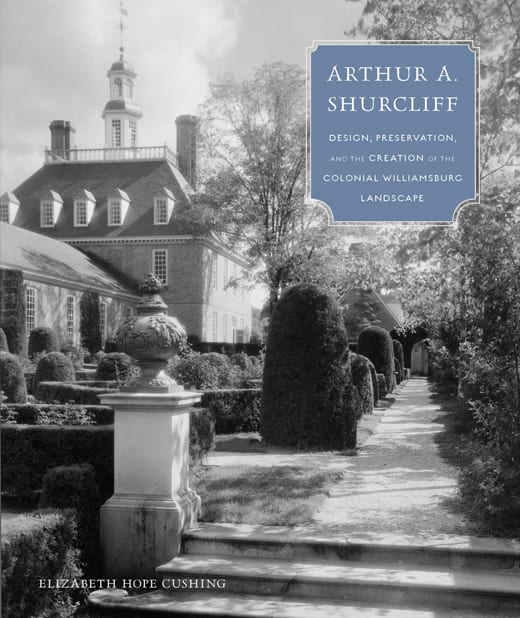ARTHUR A. SHURCLIFF GETS A JACKET
The jacket design for the forthcoming book Arthur A. Shurcliff: Design, Preservation, and the Creation of the Colonial Williamsburg Landscape by Elizabeth Hope Cushing is now off the drawing board.
Scroll down to read an excerpt from the introduction.

“The first formally trained generation of American landscape architects emerged in the late nineteenth and early twentieth centuries, most from the Brookline, Massachusetts, offices of Frederick Law Olmsted (1822–1903). Bostonian Arthur Asahel Shurcliff (1870–1957) worked in the firm for a little over seven years before establishing a regional practice and eventually a national reputation as a landscape architect, city planner, preservationist, and writer. Although he wrote comprehensively about landscape and preservation issues, designed extensively during a long and productive career, culminating in his monumental efforts in the re-creation of Colonial Williamsburg, and served as president of the American Society of Landscape Architects, his contemporary position of prominence in the field faded after his death, and his impact on the profession remains largely underappreciated. As the field of landscape history steadily rediscovers past practitioners, Shurcliff’s place in the pantheon remains indefinite. This book examines aspects of his development and the consistent threads woven through his life and oeuvre that made him not solely distinctive among the landscape practitioners of his era but uniquely suited through experience and inclination to assume the position of chief landscape architect at Colonial Williamsburg as the creation and restoration of the Virginia town began.
Shurcliff lived during a time of significant change in America. Born five years after the Civil War, he accomplished the majority of his work in an era marked by two world wars and periods of consequential economic instability. During his lifetime the country continued, at an ever-increasing pace, its transition from an essentially rural, agrarian-based economy to a rapidly industrializing nation, with all the urbanization and cultural upheavals that accompany such changes. Factory towns either sprang into existence or grew by leaps and bounds. Urban centers swelled with the influx of country people looking for steady work, combined with the burgeoning number of immigrants who responded to the promise of a better and more prosperous life a vast ocean away from home. During Shurcliff’s lifetime Americans shifted from dependence on gaslight to the use of electricity for illuminating their homes. Even more significant, however, was the rapid progression from horse power as the primary means of conveyance to the advent and rapid acceleration of automobile usage. The modernizing of America, the sprawling growth of the cities, and the birth of the ubiquitous outer ring of suburban communities did not merely occasion the need for planning but in fact demanded the creation of planning as a professional field.”
—Excerpt from the introduction to Arthur A. Shurcliff: Design, Preservation, and the Creation of the Colonial Williamsburg Landscape by Elizabeth Hope Cushing. Coming summer, 2014.